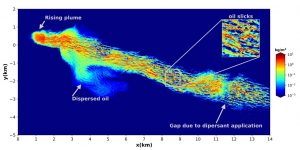Study Simulates Effectiveness of Chemical Dispersant Applications
– JANUARY 10, 2019
Scientists developed a modeling framework that includes small-scale fluid dynamics to investigate how dispersant application during Deepwater Horizon may have affected oil biodegradation and the environment. Using conditions representative of those during the spill, their simulations explored dispersant applications at the ocean surface and the well head. Application at the surface was shown to promote vertical mixing and, therefore, biodegradation, and to reduce the average transport speed by a factor of four, increase the horizontal spread by a factor of 10, and shift the transport direction by about 25 degrees. These results suggest that dispersant application on surface slicks during Deepwater Horizon may have changed the time and location that oil reached coastlines. Conversely, dispersant application at the wellhead was shown to trap most of the oil in the water column and cause the plume to expand horizontally more rapidly than if no dispersant were used, which could lead to enhanced oil dilution and biodegradation. However, the presence of background flows, even the weak flows used in this simulation, was enough to effectively separate the oil droplets from the bubble plume without dispersants.
The researchers published their findings in Physical Review Fluids: Numerical study of the effects of chemical dispersant on oil transport from an idealized underwater blowout.
Dispersant effectiveness is determined by how the reduction in oil droplet size alters complex fluid mechanical transport processes at depth (for a deep-water intrusion) and on the ocean surface (for oil slicks). Physical processes that produce turbulence govern these transport processes. Most numerical studies of Deepwater Horizon oil fate relied on regional ocean modeling, which use simple parameterizations of vertical mixing. “This study was based on a new-generation, high-fidelity numerical simulation technique called Large Eddy Simulation, which resolve large-scale 3D turbulent eddies and models smaller scales with advanced subgrid scale models,” explained study author Marcelo Chamecki.
The authors noted that their results were obtained from simulations that require major computational resources and that simulating large spatial domains (tens or hundreds of kilometers) becomes prohibitively expensive. To address this challenge, they developed an approach called ENDLESS (Extended Nonperiodic Domain LES for Scalar transport) that enables simulations of very large oil plumes at a lower computational cost. However, they said that it is reasonable to estimate that the oil slick moves with the ocean surface velocity and, after dispersant application, the oil will move with the Ekman velocity. Both velocities can be estimated from regional models yielding a first estimate of the effects of surface dispersant application on oil transport.
“Our results show that there are a few more items that one must consider in the already complex decision-making process of when and where to apply surface dispersants,” explained Chamecki. “If dispersant application alters the transport speed and direction of the oil plume, then these effects should also be incorporated into the decision-making process. Our results also suggest that the details of small-scale turbulence can be very important for performing large-scale simulations of oil plumes using regional and global models. Now is the time for development of improved parameterizations to represent the vertical mixing under different ocean conditions.”
Data are publicly available through the Gulf of Mexico Research Initiative Information and Data Cooperative (GRIIDC) at doi:10.7266/N70000F7.
The study’s authors are Bicheng Chen, Di Yang, Charles Meneveau, and Marcelo Chamecki.
By Nilde Maggie Dannreuther and Stephanie Ellis. Contact maggied@ngi.msstate.edu with questions or comments.
************
This research was made possible in part by a grant from the Gulf of Mexico Research Initiative (GoMRI) to Johns Hopkins University, Pennsylvania State University, University of California Los Angeles, and the University of Houston for their project Transport and fate of oil in the upper ocean: Studying and modeling multi-scale physical dispersion mechanisms and remediation strategies using Large Eddy Simulation.
The Gulf of Mexico Research Initiative (GoMRI) is a 10-year independent research program established to study the effect, and the potential associated impact, of hydrocarbon releases on the environment and public health, as well as to develop improved spill mitigation, oil detection, characterization and remediation technologies. An independent and academic 20-member Research Board makes the funding and research direction decisions to ensure the intellectual quality, effectiveness and academic independence of the GoMRI research. All research data, findings and publications will be made publicly available. The program was established through a $500 million financial commitment from BP. For more information, visit https://gulfresearchinitiative.org/.
© Copyright 2010-2019 Gulf of Mexico Research Initiative (GoMRI) – All Rights Reserved. Redistribution is encouraged with acknowledgement to the Gulf of Mexico Research Initiative (GoMRI). Please credit images and/or videos as done in each article. Questions? Contact web-content editor Nilde “Maggie” Dannreuther, Northern Gulf Institute, Mississippi State University (maggied@ngi.msstate.edu).






